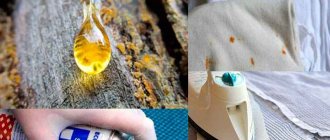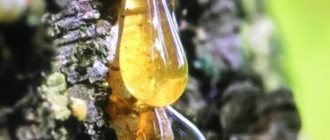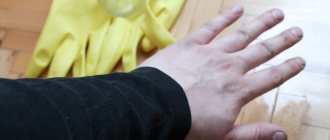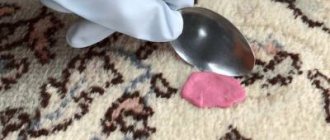It is no coincidence that stains from wood and epoxy resin are classified as difficult to remove stains. The sticky, viscous substance tightly glues the fibers of the material, and it seems that there is no way to remove the resin from clothing without leaving a mark. But don’t despair and throw your favorite jeans or jacket into the trash. There are many effective ways to get rid of tar stains at home. The choice of cleaning agent depends on the degree and duration of contamination, the type of resin and the composition of the material from which the affected clothing is made.
Where to start cleaning
To wash the resin of pine or other types of wood, you must first prepare the stained item for cleaning:
- Use a spoon or the blunt side of a knife to scrape off the top layer of resin.
- Use a dry brush to remove dust and dirt from the fabric (this will prevent streaks from appearing).
- If the garment has a lining, it should be ripped open to treat only the stain without touching the clean fabric.
- Place the matter on the board.
- Moisten the material around the stain and sprinkle with starch (this will prevent further spread of the stain).
First aid
Resin is a viscous and quite sticky substance. Before it hardens, it can smudge, stain other things, and dust and debris easily stick to it. Therefore, the first thing to take care of is to try to avoid making the situation worse.
If possible, try to remove most of the sticky composition. This can be done, for example, using wet wipes.
Resin should be removed from the edges to the middle of the stain , and upwards. By acting in this way, you will be able to avoid extensive smearing of the sticky mass on your denim pants.
Temperature effect
Pine resin and viscous contamination from poplar can be removed under the influence of temperatures. Cleaning is done by freezing or heating.
Freezing resin
The viscous substance becomes brittle at low temperatures and can be easily removed. To do this you need to do the following:
- Place ice cubes, packed in a bag, on the inside of the jeans.
- Wrap the clothes themselves in plastic.
- Place the item in the freezer for an hour and a half.
- Remove jeans and print.
- Remove the stain: the resin will crumble and be easily shaken off the fabric.
- Remove the remaining particles of the frozen mass with a brush.
Heating with an iron
Fresh dirt can be easily removed with high heat.
You need to do the following:
- Wrap the board in cloth.
- Put the thing down.
- Place a napkin on top.
- Set the iron to medium heat.
- Iron the stain.
- Periodically replace the napkin with a new one.
- Perform these steps until the stain disappears completely.
You can use a hairdryer: a hot stream of air is directed at the dirt, the resin is melted and cleaned off with a napkin.
What not to do?
The use of each cleanser requires compliance with certain rules. However, there are general recommendations and prohibitions.
When removing natural and synthetic resin, you must not:
Wash the item until the stain is completely removed. Rushing the wash can cause the resin to spread to an even larger area of the fabric.- Scrape the stain with a sharp blade. This can lead to damage to the product, especially if it is made of silk, chiffon, or wool.
- Freeze items made from thin, easily torn fabrics in the freezer, as they can easily be damaged when removing a hardened drop.
- Use acids, alcohol, solvents to clean brightly colored fabrics. Organic reagents may discolor the fibers.
Removing stains when washing
After preliminary preparation, contamination can be removed by washing. The main thing is to choose effective means that can remove it .
Vegetable oil
This affordable product is considered a gentle remedy. Mode of application:
- Apply a small amount of oil to the resin.
- After 15 minutes, the surface is cleaned with soapy water and a brush.
- The item is washed in the usual way.
Laundry soap
The cleaning procedure is simple and boils down to the following steps:
- The fabric is moistened with warm water.
- The resin is rubbed with soap.
- The fabric is kept in this state for a quarter of an hour.
- After the specified time, the item is rinsed.
- The procedure is repeated again.
Lemon acid
Under the influence of acid, the substance softens.
The cleaning procedure is carried out according to the following scheme:
- Citric acid is mixed with water in equal proportions.
- The resulting mass is applied to the contamination.
- Ten minutes later, the clothes are washed in an automatic machine.
Preparing for cleaning
Having discovered a dark tar stain on the leg or sleeve of a blouse, the first thing you need to do is remember how it could have appeared. If trouble occurs after a walk in a park planted with coniferous trees, or while picking mushrooms in a pine forest, then we are talking about tree resin. It’s another matter if the stain appeared during repairs or after going to a construction site. In this case, we can assume that the resin is epoxy.
Resin type – wood (natural) or epoxy
There are two types of resins: natural, or wood, and synthetic. But they are all characterized by incredible stickiness, the ability to quickly penetrate the fabric fibers and glue them together.
Before cleaning begins, it is necessary to correctly determine the type of resin.
- Tree resin (tar) is a viscous, oily liquid of a dark brown color. It is formed as a result of the hardening of the sap of some trees. Resin is produced by pine trees, spruce trees, larches, poplar buds, thuja and other plants.
- Epoxy resin is a representative of synthetic substances, as it is produced chemically. Such resins are widely used in households, construction, and manufacturing. Epoxy exhibits its binding properties only when combined with a hardener and is resistant to acids and alkalis.
Vegetable stains are much easier to remove than stains caused by epoxy resin.
Fabric material
To select a cleaning product, it is important to know what fabric the stained jacket or blouse is made of. Otherwise, a hole may form in place of the stain, the paint may peel off, or some other problem may occur.
The composition of the material and methods of caring for the product are indicated on the label. If the information is erased or the label is cut off immediately after purchase, you should follow these rules:
- Wool and natural silk do not tolerate exposure to strong alkaline solutions. To clean the surface of these materials from resin, ammonia or a mixture of starch (1 tsp) and turpentine (5-6 drops) is used.
- Turpentine or acetone will help remove the viscous substance from cotton fabric When the resin has dissolved, wipe the contaminated area with alcohol and rinse with water.
- Acetate silk and bologna fabric are treated with purified gasoline. Acetic acid and acetone should not be used to process these materials.
- Nylon and nylon do not tolerate treatment with gasoline, benzene and alkaline solutions. Resin stains from these materials must be removed with warm water and laundry soap.
- Leather items cannot withstand exposure to solvents. For them, the best cleaning agent is vegetable oil.
- stained with wood resin can be easily cleaned with turpentine and ammonia, using them in equal quantities. Potato starch is added to the solution to obtain a thick paste, and the area of contamination is coated. After drying, the remaining paste is brushed off and the pants are washed.
- A jacket made of membrane fabric can be scrubbed using turpentine and laundry soap. Turpentine is diluted with water in a ratio of 1:2, grated soap is added to the mixture and the soiled part of the clothing is washed.
Fresh or old stain?
A fresh stain that has just appeared is always easier to remove than an old one. Therefore, as soon as a resin blot is discovered, you must immediately begin cleaning:
- Use a paper napkin or handkerchief to blot the resin, trying to collect a thick mass from the surface of the material.
- Do not wash, much less soak, the product. This will not help the matter; the stain will spread even more.
- If you don't have a stain remover on hand, you can try to get rid of the stain using vegetable oil. In case of failure, you will have to start processing with other substances suitable for the composition of the fabric.
Fresh stains usually have a blurred outline and are darker in color than the fabric. Old stains have a clear outline, they are lighter than the fabric, and appear both from the face and from the inside.
How to prepare things for stain removal?
Before applying the cleaning agent, the affected product must be prepared as follows:
- Shake out the dust and clean the surface of the clothing with a brush.
- Test the durability of the fabric in an inconspicuous area, such as a pocket or side inseam.
- Place the product on a table or floor and place a board wrapped in cotton material under the stain.
- If the product has a lining, it is peeled off in advance so that it is possible to place a board between the top and the lining fabric.
- The fabric around the stain is moistened with water. This will prevent the formation of divorces.
The product is ready for cleaning. Now all you have to do is choose the right tool - and you can get to work.
Use of solvents
Not all known means can cope with severe stains. We have to resort to the use of aggressive substances - solvents.
The most effective of them:
- acetone;
- turpentine;
- petrol.
Solvents can lighten the fabric, so before cleaning, you should test their effect on a small area of the jeans in an inconspicuous place.
Removal is carried out in several stages:
- A cotton swab is soaked in the solvent and the areas with resin are treated.
- After a quarter of an hour, the item is washed first by hand and then by machine.
- The jeans are dried in the fresh air (this removes the sharp, unpleasant smell of the solvent).
Additional recommendations
For the procedure to be safe and effective, you must adhere to the following recommendations:
- when using flammable materials, all actions are performed at a sufficiently large distance from sources of fire;
- clothing is processed from the reverse side;
- a substance used for the first time is tested on an inconspicuous area and only if there are no negative changes is used to remove the stain;
cleaning is carried out from the edge of the contamination to the center: due to this, it will be possible to prevent its increase in diameter;- You need to perform careful blotting movements;
- You cannot use gasoline when processing stretch;
- Apply the cleaning agent to small spots with a pipette or a cotton swab;
- To get rid of the unpleasant smell of cleaners when washing clothes, use conditioner;
- dry your jeans in the fresh air.
By following all the recommendations, strictly following the instructions and choosing the right products, you can easily remove resin from denim.
The main thing is not to rush, to maintain the specified dosage of substances, otherwise the situation will only worsen and your favorite thing will deteriorate.
Previous
Wardrobe careShoes rub your heels: causes and methods of solving the problem
Next
Caring for your wardrobeWashing a dress made of natural silk: rules and step-by-step instructions for hand and machine washing
Factory stain removers
Special stain removers can cope with the task. You need to choose a product suitable for processing denim.
You need to do the following:
- Read the instructions and the safety precautions described therein.
- Apply stain remover to the stain.
- Leave for about half an hour. The duration of the procedure largely depends on the strength of the components included in the product. The exact time is indicated on the packaging. There is also information about dosage.
- Jeans are machine washed with the addition of the same stain remover.
Other resin removers
List of means that can be used to remove resin from clothes:
- Sweet sparkling water. The maximum effect is observed when using Coca-Cola. Jeans need to be placed in a basin, pour soda into it and soak the item for five hours, then clean the resin with a brush. The method is considered gentle and safe. No sharp objects are used when using it. The dirt softens and can be easily removed with a regular brush.
- Alcohol. Soak cotton wool or gauze in the liquid and apply the product to the stain. The item is kept for about half an hour. It's not worth a lot of alcohol. The main thing is that the contaminated area is wet. After treatment, clothes should be rinsed and washed.
- White spirit. The product is absolutely safe and will not harm denim fabric. It must be applied to the resin and wait until the contamination is completely dissolved.
- Milk. It is enough to soak the contaminated area of fabric in milk for an hour, and then wash the clothes in regular cool water. There will be no trace left of the stain.
Prohibitions
When cleaning denim trousers, it is necessary to take into account a number of prohibitions:
- The use of sharp objects (knife, blade) is only allowed to a limited extent to cut off the top volumetric layer of resin. The lower part of the stain, which is in direct contact with the fabric, cannot be removed in this way, as there is a risk of damage to the material.
- You should not try to wash a fresh stain under running water, as this will only lead to even more smearing of the resin on the jeans.
- You should not pour or pour everything that is at hand onto the stain. The effect of such an impact will not be predictable. Possible damage to the fabric, loss of brightness of the jeans.
What not to do
When cleaning denim clothes, you need to know what actions cannot be performed, otherwise the item will be damaged.
This:
- Do not put clothes into the washing machine without first treating the tar stain: it will not wash off and will spread over large areas.
- Do not rub the stain too hard, otherwise the viscous substance will penetrate deep into the fabric and make cleaning more difficult. If the jeans are light, then it is almost impossible to remove dirt from them after this.
- Don't leave cleaning for later. Contamination should be removed as quickly as possible, otherwise the substance will penetrate deep into the tissue structure and will be more difficult to remove .
How and with what to clean tree resin from wood from clothes?
Wood resin is quite liquid and can eat into fabric.
Methods for removing tree resin:
- Nail polish remover
- Acetone
- Paint thinner
- Vegetable oils
How and with what to clean tree resin from wood from clothes?











